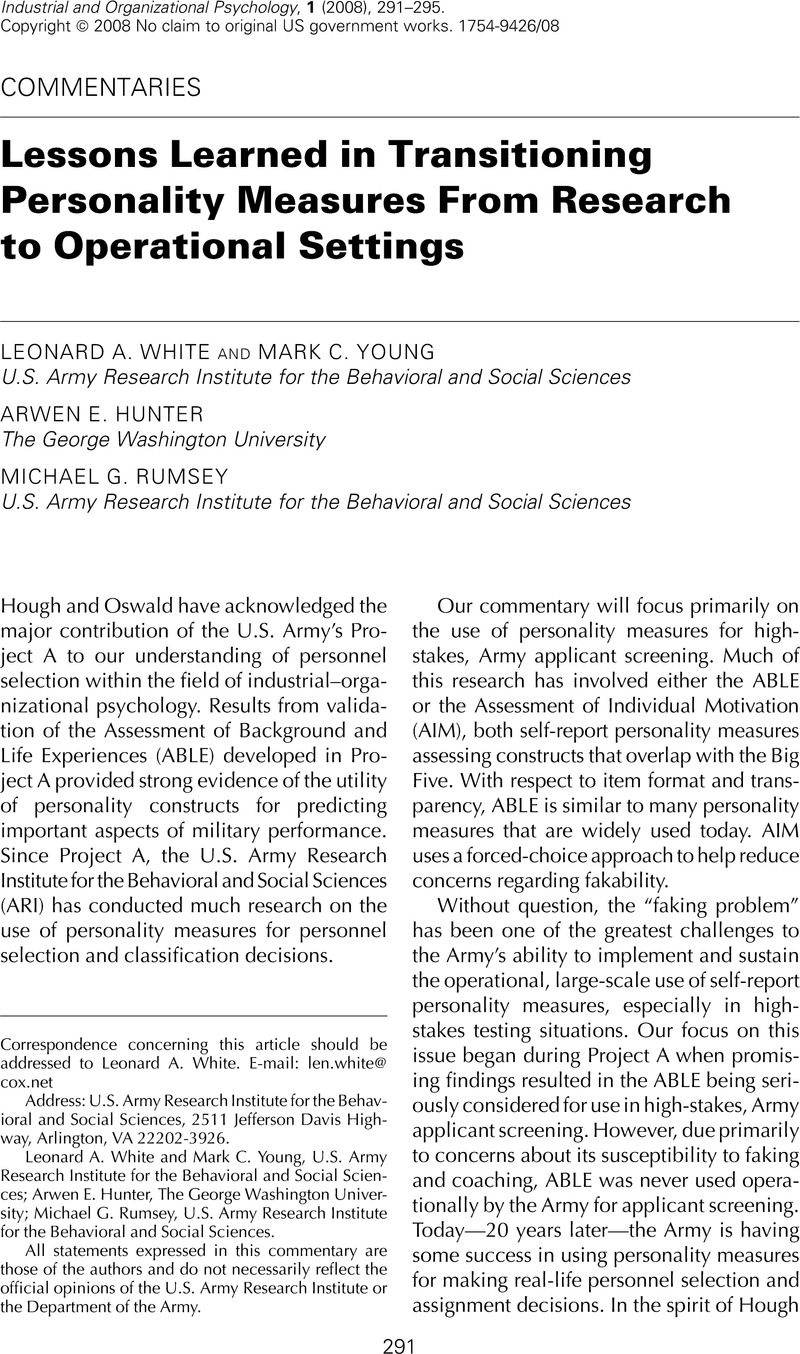Crossref Citations
This article has been cited by the following publications. This list is generated based on data provided by
Crossref.
Oswald, Frederick L.
and
Hough, Leaetta M.
2008.
Personality Testing and Industrial–Organizational Psychology: A Productive Exchange and Some Future Directions.
Industrial and Organizational Psychology,
Vol. 1,
Issue. 3,
p.
323.
Holden, Ronald R.
and
Passey, Jennifer
2010.
Socially desirable responding in personality assessment: Not necessarily faking and not necessarily substance.
Personality and Individual Differences,
Vol. 49,
Issue. 5,
p.
446.
O'Brien, Erin
and
LaHuis, David M.
2011.
Do Applicants and Incumbents Respond to Personality Items Similarly? A Comparison of Dominance and Ideal Point Response Models.
International Journal of Selection and Assessment,
Vol. 19,
Issue. 2,
p.
109.
Fleisher, Matthew S.
Woehr, David J.
Edwards, Bryan D.
and
Cullen, Kristin L.
2011.
Assessing within-person personality variability via frequency estimation: More evidence for a new measurement approach.
Journal of Research in Personality,
Vol. 45,
Issue. 6,
p.
535.
Hough, Leaetta M.
and
Johnson, Jeff W.
2012.
Handbook of Psychology, Second Edition.
Sackett, Paul R.
Putka, Dan J.
and
McCloy, Rodney A.
2012.
The Oxford Handbook of Personnel Assessment and Selection.
p.
91.
White, Leonard A.
Rumsey, Michael G.
Mullins, Heather M.
Nye, Christopher D.
and
LaPort, Kate A.
2014.
Toward a New Attrition Screening Paradigm: Latest Army Advances.
Military Psychology,
Vol. 26,
Issue. 3,
p.
138.
Allen, Matthew T.
Bynum, Bethany H.
Oliver, Joy T.
Russell, Teresa L.
Young, Mark C.
and
Babin, Nehama E.
2014.
Predicting Leadership Performance and Potential in the U.S. Army Officer Candidate School (OCS).
Military Psychology,
Vol. 26,
Issue. 4,
p.
310.
Rumsey, Michael G.
and
Arabian, Jane M.
2014.
Military Enlistment Selection and Classification: Moving Forward.
Military Psychology,
Vol. 26,
Issue. 3,
p.
221.
Holden, Ronald R.
Lambert, Christine E.
D'Agata, Madeleine T.
and
Book, Angela S.
2017.
Response patterns for the identification of fakers: Detecting drifting dissimulators.
Personality and Individual Differences,
Vol. 108,
Issue. ,
p.
195.
Frazier, M. Lance
Fainshmidt, Stav
Klinger, Ryan L.
Pezeshkan, Amir
and
Vracheva, Veselina
2017.
Psychological Safety: A Meta‐Analytic Review and Extension.
Personnel Psychology,
Vol. 70,
Issue. 1,
p.
113.
Rumsey, Michael G.
2020.
Introduction to the special issue on noncognitive testing.
Military Psychology,
Vol. 32,
Issue. 1,
p.
1.
Nye, Christopher D.
White, Leonard A.
Drasgow, Fritz
Prasad, Joshua
Chernyshenko, Oleksandr S.
and
Stark, Stephen
2020.
Examining personality for the selection and classification of soldiers: Validity and differential validity across jobs.
Military Psychology,
Vol. 32,
Issue. 1,
p.
60.
Nye, Christopher D.
White, Leonard A.
Horgen, Kristen
Drasgow, Fritz
Stark, Stephen
and
Chernyshenko, Oleksandr S.
2020.
Predictors of attitudes and performance in U.S. Army recruiters: Does personality matter?.
Military Psychology,
Vol. 32,
Issue. 1,
p.
81.
Trent, John D.
Barron, Laura G.
Rose, Mark R.
and
Carretta, Thomas R.
2020.
Tailored Adaptive Personality Assessment System (TAPAS) as an indicator for counterproductive work behavior: Comparing validity in applicant, honest, and directed faking conditions.
Military Psychology,
Vol. 32,
Issue. 1,
p.
51.
Du, Juan
Ma, Emily
and
Lin, Xinyue
2021.
When diversity leads to divided teams: A multi-level moderated mediation model of team faultlines and employee engagement.
International Journal of Hospitality Management,
Vol. 94,
Issue. ,
p.
102818.
Holden, Ronald R.
and
Marjanovic, Zdravko
2021.
Faking on a self-report personality inventory: Indiscriminate, discriminate, or hyper-discriminate responding?.
Personality and Individual Differences,
Vol. 169,
Issue. ,
p.
109768.
Jang, Jihee
Yoon, Seowon
Son, Gaeun
Kang, Minjung
Choeh, Joon Yeon
and
Choi, Kee-Hong
2022.
Predicting Personality and Psychological Distress Using Natural Language Processing: A Study Protocol.
Frontiers in Psychology,
Vol. 13,
Issue. ,
Nye, Christopher D.
and
Hoff, Kevin A.
2023.
Getting interested in interests for employee selection: Key concerns and areas for future research.
International Journal of Selection and Assessment,
Vol. 31,
Issue. 4,
p.
494.
Hou, Xin Daphne
Guntuku, Sharath Chandra
Cho, Young-Min
Sherman, Garrick
Zhang, Tingdan
Li, Mingyang
Ungar, Lyle
Tay, Louis
and
Chen, Tinggui
2024.
A cross-cultural examination of temporal orientation through everyday language on social media.
PLOS ONE,
Vol. 19,
Issue. 3,
p.
e0292963.





